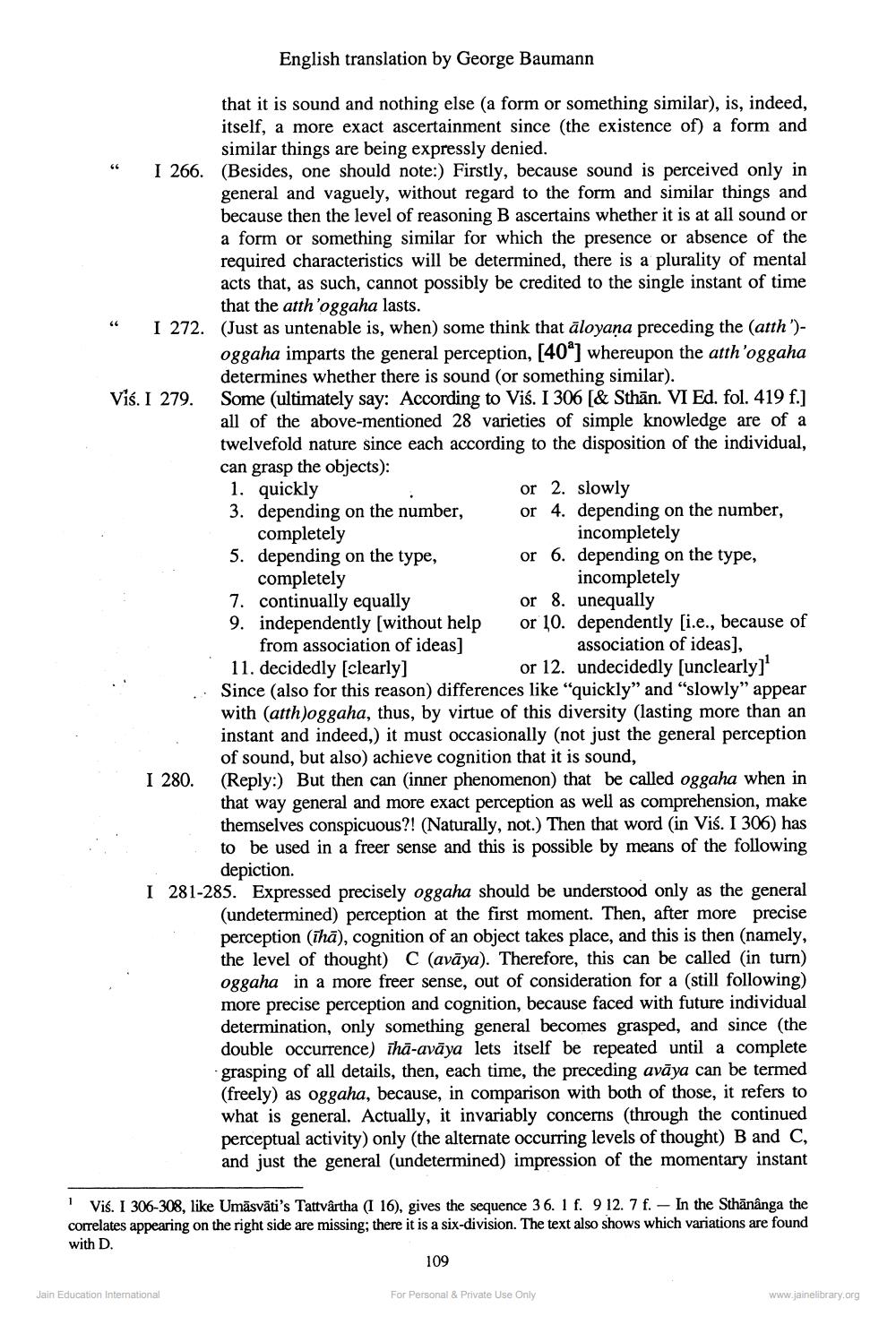________________
1
66
66
English translation by George Baumann
that it is sound and nothing else (a form or something similar), is, indeed, itself, a more exact ascertainment since (the existence of) a form and similar things are being expressly denied.
I 266. (Besides, one should note:) Firstly, because sound is perceived only in general and vaguely, without regard to the form and similar things and because then the level of reasoning B ascertains whether it is at all sound or
a form or something similar for which the presence or absence of the required characteristics will be determined, there is a plurality of mental acts that, as such, cannot possibly be credited to the single instant of time that the atth'oggaha lasts.
I 272. (Just as untenable is, when) some think that aloyaṇa preceding the (atth')
oggaha imparts the general perception, [40] whereupon the atth'oggaha determines whether there is sound (or something similar).
Some (ultimately say: According to Viś. I 306 [& Sthan. VI Ed. fol. 419 f.] all of the above-mentioned 28 varieties of simple knowledge are of a twelvefold nature since each according to the disposition of the individual, can grasp the objects):
1. quickly
3. depending on the number, completely
5. depending on the type, completely
7. continually equally
9. independently [without help from association of ideas]
Viś. I 279.
I 280.
or 2. slowly
or 4. depending on the number, incompletely
or 6. depending on the type, incompletely
Jain Education International
or 8. unequally
or 10. dependently [i.e., because of association of ideas],
or 12. undecidedly [unclearly]1
11. decidedly [clearly] Since (also for this reason) differences like "quickly" and "slowly" appear with (atth)oggaha, thus, by virtue of this diversity (lasting more than an instant and indeed,) it must occasionally (not just the general perception of sound, but also) achieve cognition that it is sound,
(Reply:) But then can (inner phenomenon) that be called oggaha when in that way general and more exact perception as well as comprehension, make themselves conspicuous?! (Naturally, not.) Then that word (in Viś. I 306) has to be used in a freer sense and this is possible by means of the following depiction.
I 281-285. Expressed precisely oggaha should be understood only as the general (undetermined) perception at the first moment. Then, after more precise perception (ihā), cognition of an object takes place, and this is then (namely, the level of thought) C (avāya). Therefore, this can be called (in turn) oggaha in a more freer sense, out of consideration for a (still following) more precise perception and cognition, because faced with future individual. determination, only something general becomes grasped, and since (the double occurrence) iha-avāya lets itself be repeated until a complete grasping of all details, then, each time, the preceding avaya can be termed (freely) as oggaha, because, in comparison with both of those, it refers to what is general. Actually, it invariably concerns (through the continued perceptual activity) only (the alternate occurring levels of thought) B and C, and just the general (undetermined) impression of the momentary instant
Viś. I 306-308, like Umäsväti's Tattvârtha (I 16), gives the sequence 36. 1 f. 912. 7 f. In the Sthänânga the correlates appearing on the right side are missing; there it is a six-division. The text also shows which variations are found with D.
109
For Personal & Private Use Only
www.jainelibrary.org




